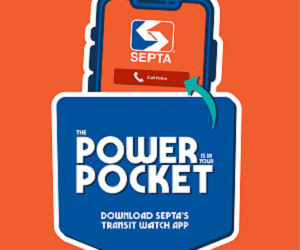
Rail Safety Week 2021
September 14, 2021

Operation Lifesaver, Inc. (OLI), the national rail safety education nonprofit, works in partnership with the U.S. Department of Transportation and other organizations to observe Rail Safety Week (RSW) each year.
The goal of Rail Safety Week [9/20/21 - 9/26/21] is to raise awareness of the need for rail safety education and empower the general public to keep themselves safe near highway-rail grade crossings and railroad rights-of-way. Join us in observing Rail Safety Week this year!

Annually, more than 2,100 people are injured or killed in rail crossing and trespassing incidents in North America. Every three hours - a person or car is struck by a train in the United States. More than 50% of collisions occur at crossings equipped with lights and/or gates.
There are some easy and simple steps you can take to keep you and the people around you safe. For example - here are things you should - and shouldn't - do while waiting for a ride:
-
Do not attempt to board a moving vehicle. Passengers could be seriously injured or even killed if they fall into or under vehicles.
-
Do not stand or lean into the path of an incoming vehicle. Always stand at least a few feet away from the tracks.
-
Do not put your hand, pocketbook, umbrella, or any other object in the closing door of a vehicle.
Here are some more track safety basics:
-
Freight trains don't travel at fixed times, and schedules for passenger trains often change. Always expect a train at each highway-rail intersection at any time.
-
All train tracks are private property. Never walk on tracks; it's illegal trespass and highly dangerous. It takes the average freight train traveling at 55 mph more than a mile—the length of 18 football fields—to stop. Trains cannot stop quickly enough to avoid a collision.
-
The average locomotive weighs about 400,000 pounds or 200 tons; it can weigh up to 6,000 tons. This makes the weight ratio of a car to a train proportional to that of a soda can to a car. We all know what happens to a soda can hit by a car.
-
Trains have the right of way 100% of the time over emergency vehicles, cars, the police and pedestrians.
-
A train can extend three feet or more beyond the steel rail, putting the safety zone for pedestrians well beyond the three foot mark. If there are rails on the railroad ties, always assume the track is in use, even if there are weeds or the track looks unused.
-
Trains can move in either direction at any time. Sometimes its cars are pushed by locomotives instead of being pulled, which is especially true in commuter and light rail passenger service.
-
Today's trains are quieter than ever, producing no telltale "clackety-clack." Any approaching train is always closer, moving faster, than you think.
-
Remember to cross train tracks ONLY at designated pedestrian or roadway crossings, and obey all warning signs and signals posted there.
-
Stay alert around railroad tracks. Refrain from texting, headphones or other distractions that would prevent you from hearing an approaching train; never mix rails and recreation.
For more information about SEPTA safety and to download PDFs of safety tips for all SEPTA modes, click here. For more information about Rail Safety Week, click here.



